Some of the links in this post may be affiliate links.
Have you been curious about growing Phalaenopsis orchids in LECA (lightweight expanded clay aggregate)? If you’d like to experiment with a potting medium other than orchid bark (fir bark) or sphagnum moss, converting orchids to LECA clay pellets is a fun project, and I will lay it out for you step by step right here!
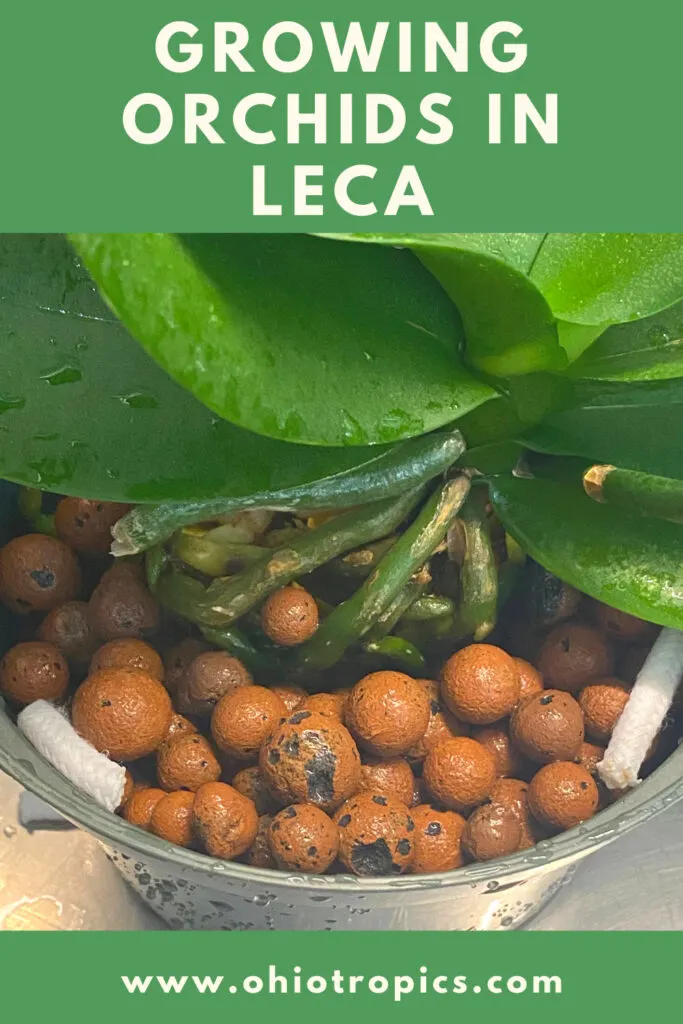
This method is considered to be a semi-hydroponic method. Using LECA pebbles as a growing medium will make it much easier to manage your orchid’s moisture needs. And all without the fear of root rot.
If you use the set up I describe below, your orchid roots will be provided with the correct amount of moisture to the root zone, eliminating guess work, all while allowing for good air circulation around the roots!
Table of Contents
HOW TO CONVERT ORCHIDS TO LECA
I’m going to show you exactly how I created my set-up, and then I do have some comments for alternative set-ups and some additional things to consider.
One thing I will say is to convert maybe one or two plants and monitor them over time. Don’t convert your entire collection until you try it out and are happy with the results!
I would recommend reading through this entire post first before deciding what configuration you’d like to use. You may not want to use all the materials I show and may want to make your own modifications.
MATERIALS LIST
The following is a list of materials that I used and that you’ll need if you want to replicate things exactly as I have laid out in this post (all links point to Amazon).
You can certainly do many variations with different types of self-watering pots, so don’t be afraid to use the same general process as I’ve laid out below if you’d like a different size or style pot. You can easily get creative and use some materials that you may already have for a DIY set-up.
Self-Watering Capillary Wick Cord
This synthetic cord will wick water from the water reservoir in the self-watering planter up to the LECA in the pot. Do not use anything made of 100% cotton as it will eventually rot.
The purpose of the wick is so it can transport water from the water reservoir of the self-watering pot to the LECA balls. It does so by a process called capillary action.
Lechuza Cube Self-Watering Planter
This is the self-watering planter that I used in this post. It does NOT come up an inner pot for your plant, so you’ll have to get that separately.
There are many self-watering pots out there, so if you don’t like this one, choose another that you like!
I simply used a plastic 6 inch diameter Azalea pot that fit perfectly inside the Lechuza Cube planter. The particular pot I used is 6 inches in diameter and just under 4 1/4 inches tall. I found the pot at a garden center and lucked out because it fit perfectly inside my self-watering planter!
If you choose to use another type of self watering pot, just be aware of the dimensions of the interior to make sure that the inner pot that you actually have your plant growing in will fit nicely!
Hydroton Original Expanded Clay Pebbles (LECA)
This is the LECA I used and is very high quality. LECA is produced by adding clay pellets to a rotary kiln where they are exposed to high temperatures and essentially pop like popcorn! This results in lightweight clay balls that are full of tiny air spaces.
My go-to fertilizer that I use for all my houseplants.
Lastly, you’ll need scissors to cut your wick and a lighter to seal the ends of the wick cord I used.
Disclaimer: I do not discuss adjusting pH in this post. pH is a measure of how acidic or alkaline an aqueous solution is. Many orchid resources talk about an ideal pH range between 5.5-6.5 (slightly acidic) for best results.
pH does play an important part in nutrient availability for plants. What I talk about in this post is an experiment and my first attempt at growing orchids in LECA, and I will eventually explore pH effects on moth orchid growth and development.
I will update this post with any important findings that I make as I live with my setups! That being said, I know of a lot of people that successfully grow moth orchids in LECA without pH adjustments and they’re doing well, so go ahead and experiment!
Now let’s get into how I made my setup.
1. PREPARE YOUR LECA FOR ORCHIDS
The first thing you’ll want to do is to rinse your LECA. I like to place my LECA in a colander and rinse with a hose. This will help remove any dust.
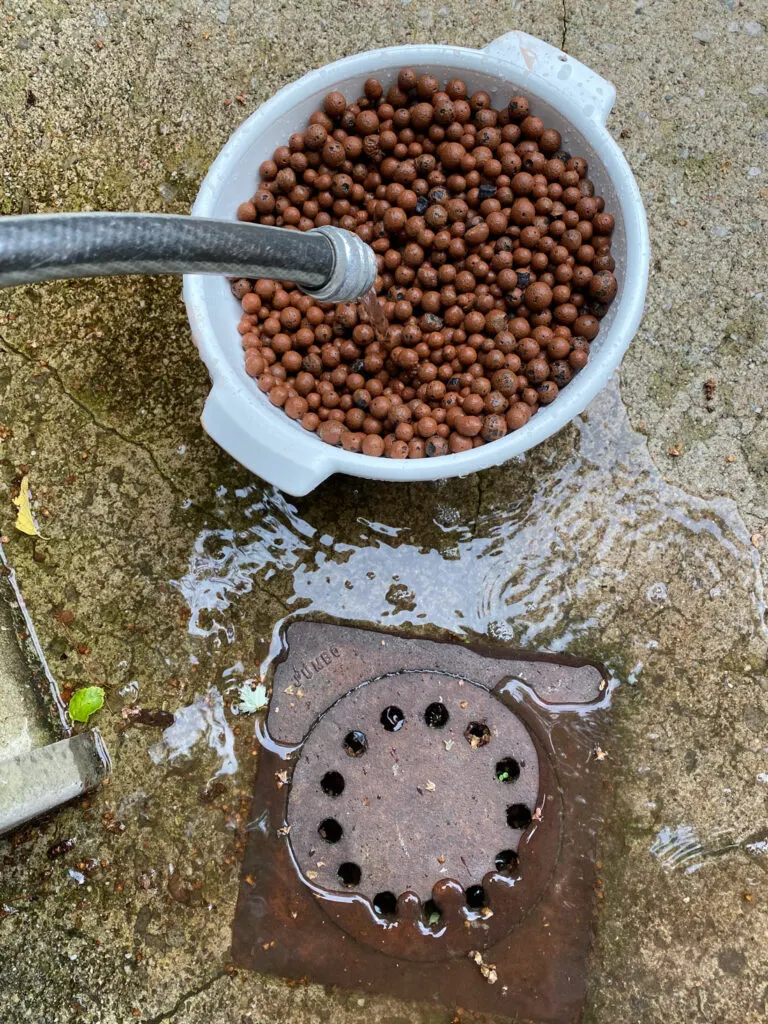
Next, you’ll want to soak your LECA in a plastic bucket or bowl of water for at least 1-2 days. This will help to remove any impurities and hydrate your LECA.
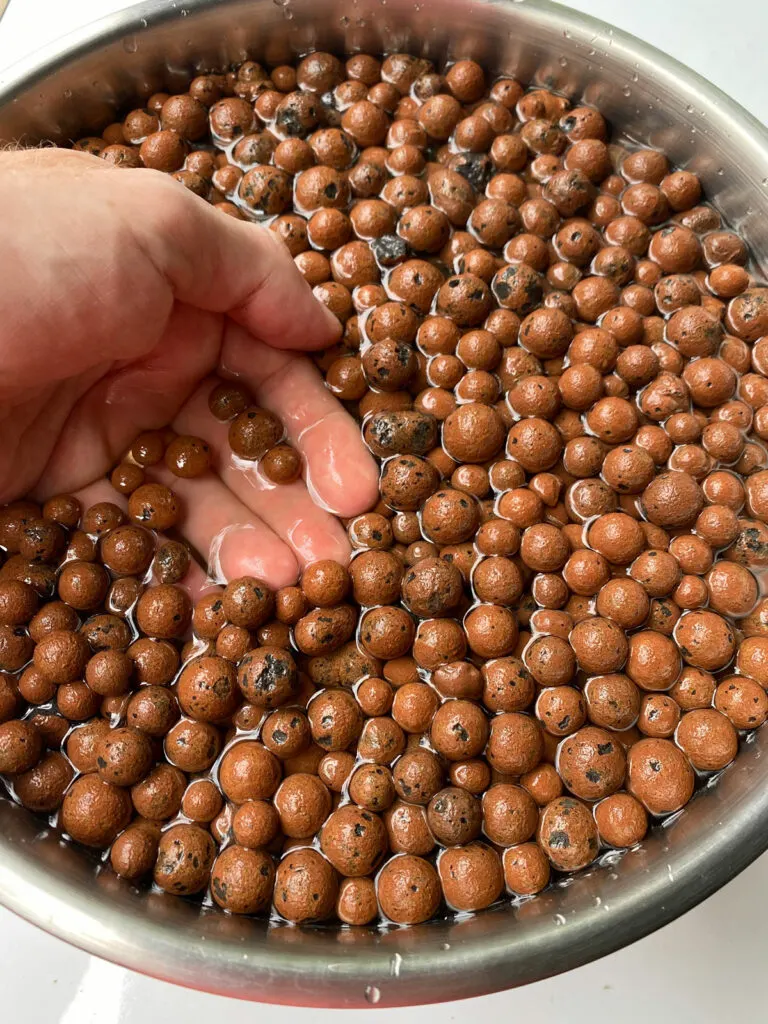
2. PREPARE YOUR ORCHID
Next, choose an orchid that you’d like to convert to LECA. The one I chose was growing in sphagnum moss.
First, I gave my plant a good watering. This makes it easier to remove the sphagnum moss (or fir bark)…whatever your plant happens to be growing in.
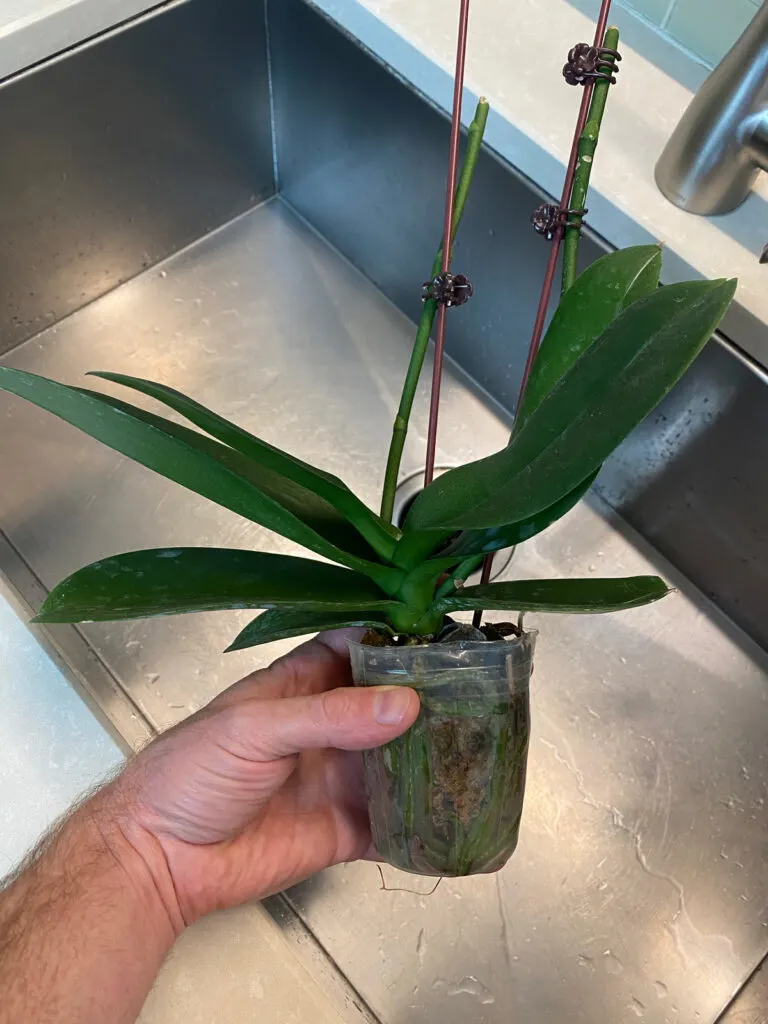
Next, I removed the plant out of its pot.
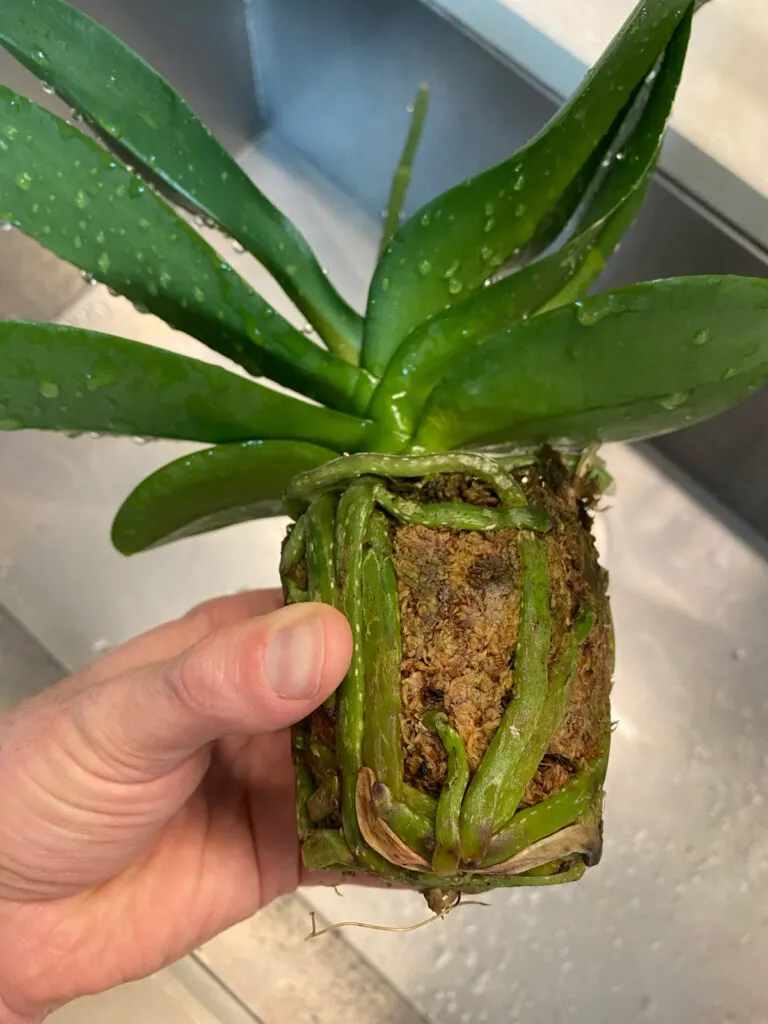
At this point, I gently removed the sphagnum moss as well as any dead roots. Most of the root system was very healthy and I didn’t have to trim many roots.
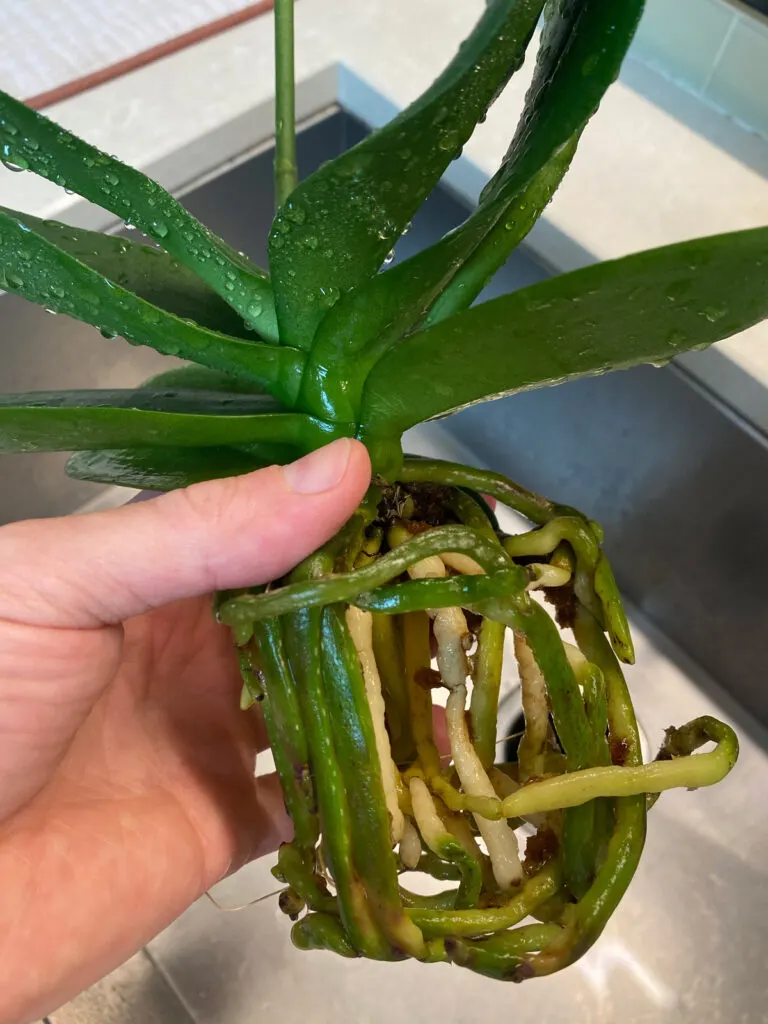
Next, you can prepare the self-watering wick.
If you want to learn all about how to get your orchid to rebloom reliably and have healthy, thriving moth orchid plants, don’t miss my signature, online orchid care course, Become an Orchid Master. It also includes bonuses with support from me, personally, to guide you in your orchid journey!
3. PREPARE THE SELF-WATERING WICK
I’ve used the Orimerc Self-Watering Capillary Wick Cord before for self-watering set-up using potting mixes and absolutely love it.
I cut 4 separate pieces of the wick cord. I added up the height of my plastic pot and added two inches to that. After you cut the cord, take a lighter and gently pass it over each end of the cords.
This will eliminate any frayed ends and essentially melts the end of the cord so it stays together.
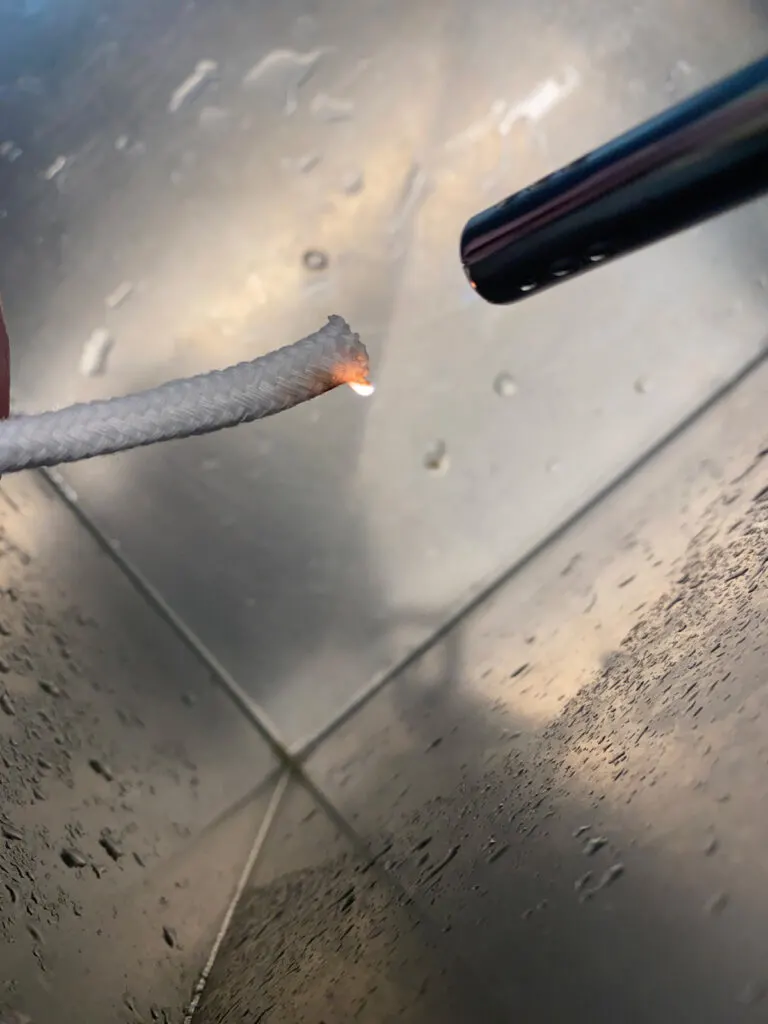
Here is what it looks like after sealing the ends with a flame.
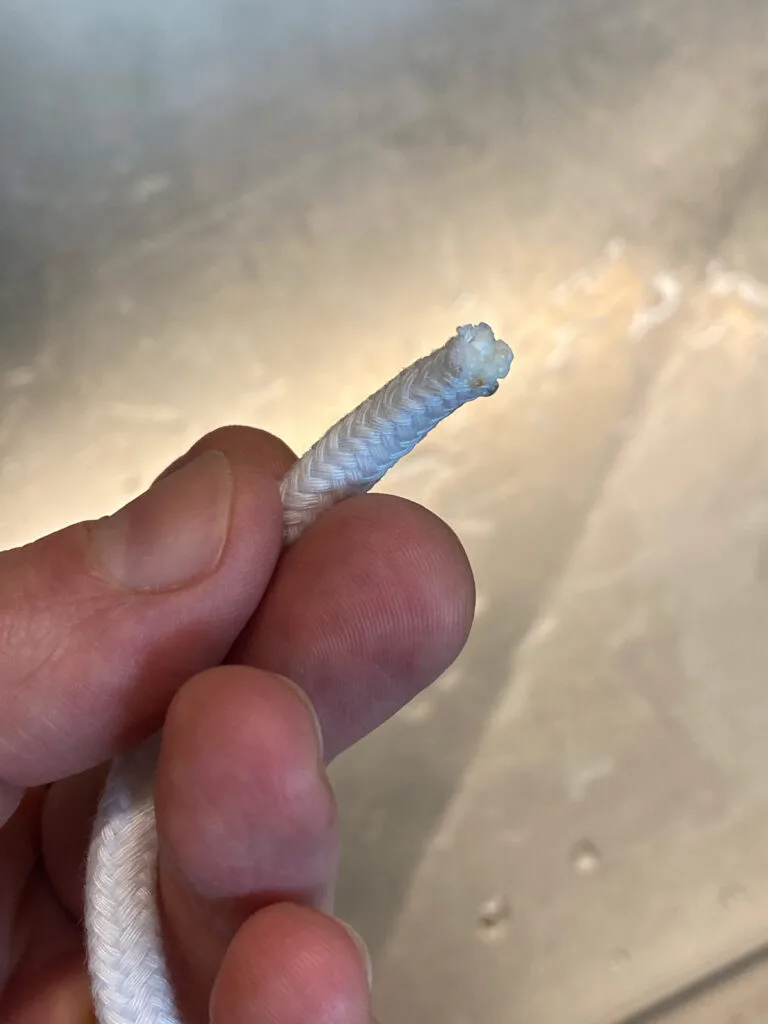
Next, I put each of the pieces of wick through drainage holes, as shown in the photo below. I left about a couple inches of wick sticking out at the bottom of the pot.
This portion of the wick at the bottom of the pot will be the part that will be resting in the water reservoir in the self-watering pot.
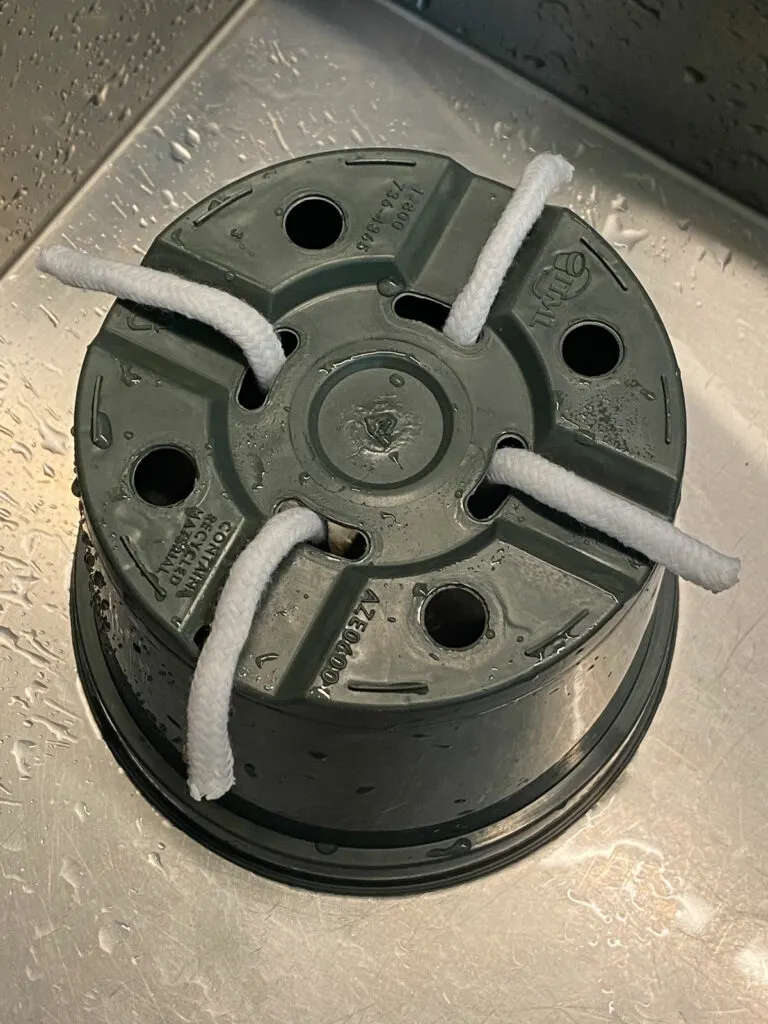
4. PLANT YOUR ORCHID
Next, turn your pot right-side up and place some LECA in.
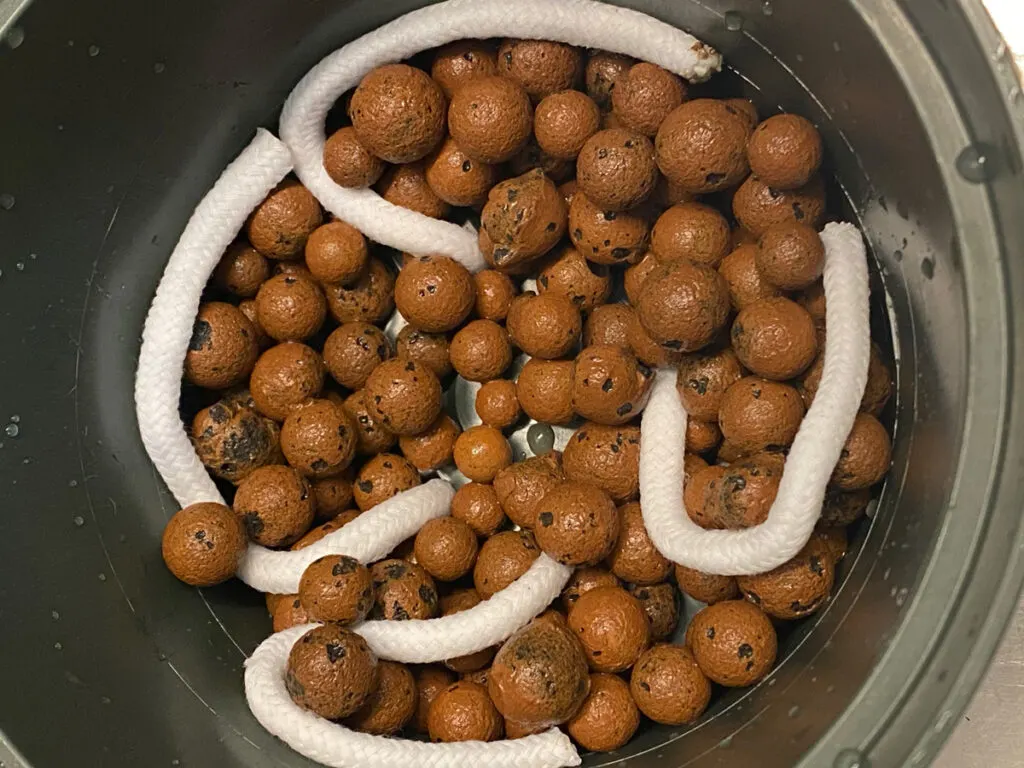
You may have to play with the level of the LECA a bit to make sure that your plant ends up at the right level. Next, go ahead and place your orchid in and adjust the wick sections as needed.
Make sure that you have about a couple inches of wick sticking out of the bottom of the pot through the drainage holes.
Keep adding LECA and adjusting the wicks inside the pot until the wick pieces are almost up to the rim of the pot.
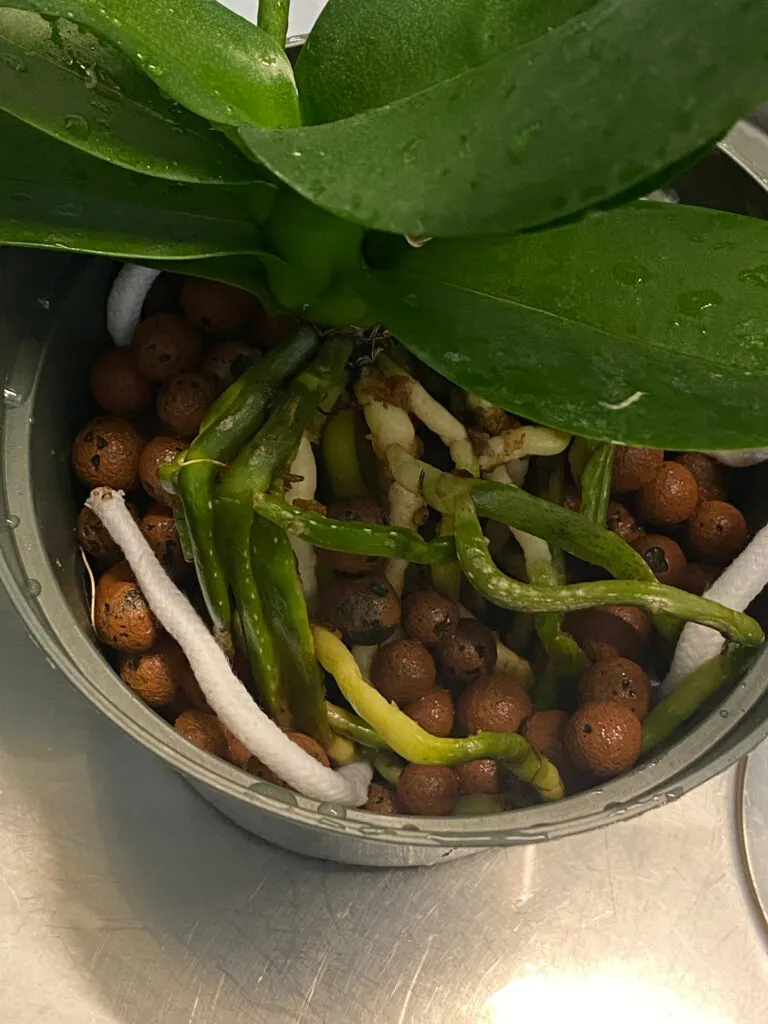
Lastly, add more LECA on top so you can’t see the wicks anymore. The bottom of the pot should look something like this.
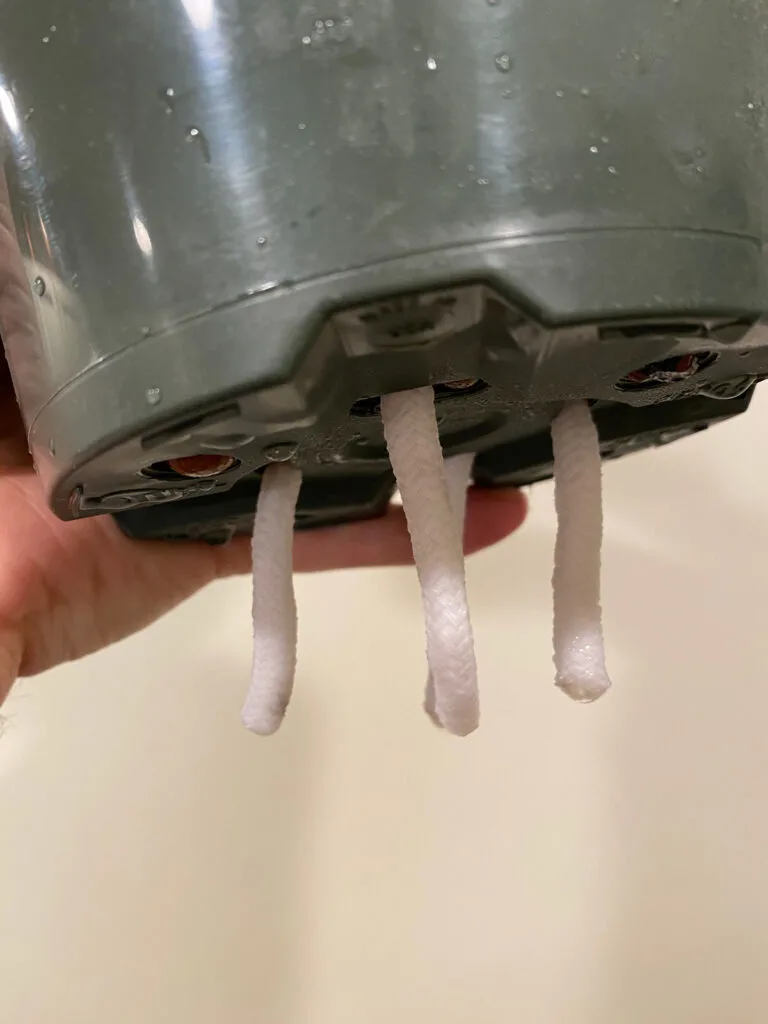
The inside of the Lechuza pot will look like this. The nursery pot that I planted the orchid in will rest on the black platform (the pot itself does NOT sit in water) and the wicks at the bottom of the pot will hang into the water reservoir.
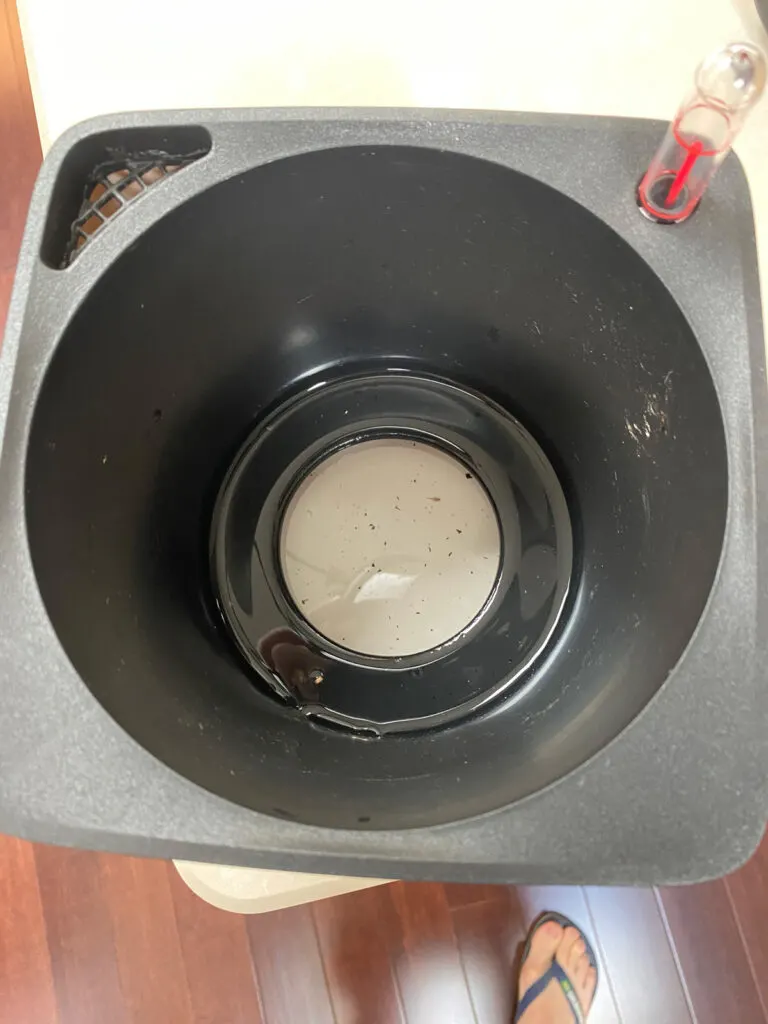
Next, slip the pot into the Lechuza Cube Self-Watering Planter.
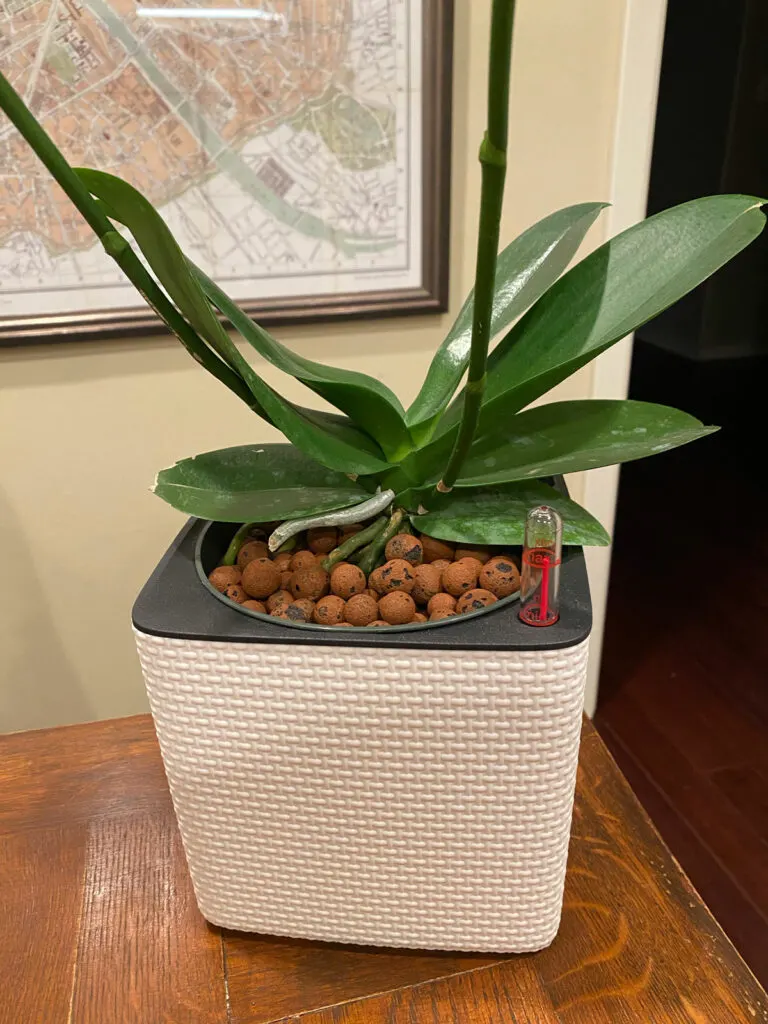
Lastly, you’ll want to add enough water to keep the water gauge between the min and max lines. As you add more water, you’ll see the red plastic stick rise vertically.
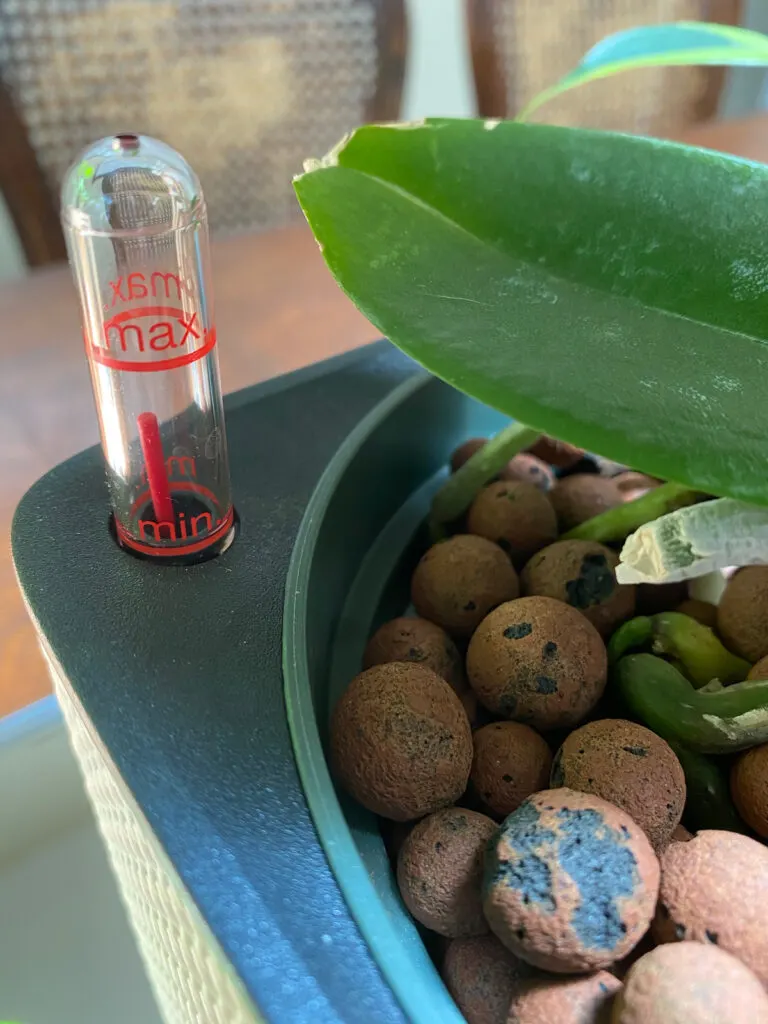
5. ROUTINE CARE & MONITORING
At this point all you have to do is monitor your orchid and keep an eye on the water level.
In this set-up, your plant’s roots will never be sitting in water. Orchids are epiphytes and grow on trees in their natural habitat so they should never be sitting in water.
Be careful not to let your water reservoir go completely empty and to the point where the wick and LECA go completely dry. If this happens, take the plastic pot out and give the LECA and wicks a good soaking in your sink and place them back in the self-watering pot.
When I top off the water in my self-watering pot, I use a nutrient solution of Dyna-Gro Grow Fertilizer. It is important to add nutrients for good growth.
Orchids don’t need much fertilizer, but I like to add 1/4-1/2 teaspoon of Dyna-Gro Grow Fertilizer to a gallon of tap water and use that at all times in the self-watering pot.
If you start to see white crusty build-up on the LECA balls, go ahead and slip the pot out and flush the LECA in your sink with plain, fresh water for a minute or two, and then place it back in the self-watering pot. This will help to remove any accumulated salts which can damaging to orchid roots.
ALTERNATE SET-UPS
If you want to make a more DIY set up, take a look at this set-up below:
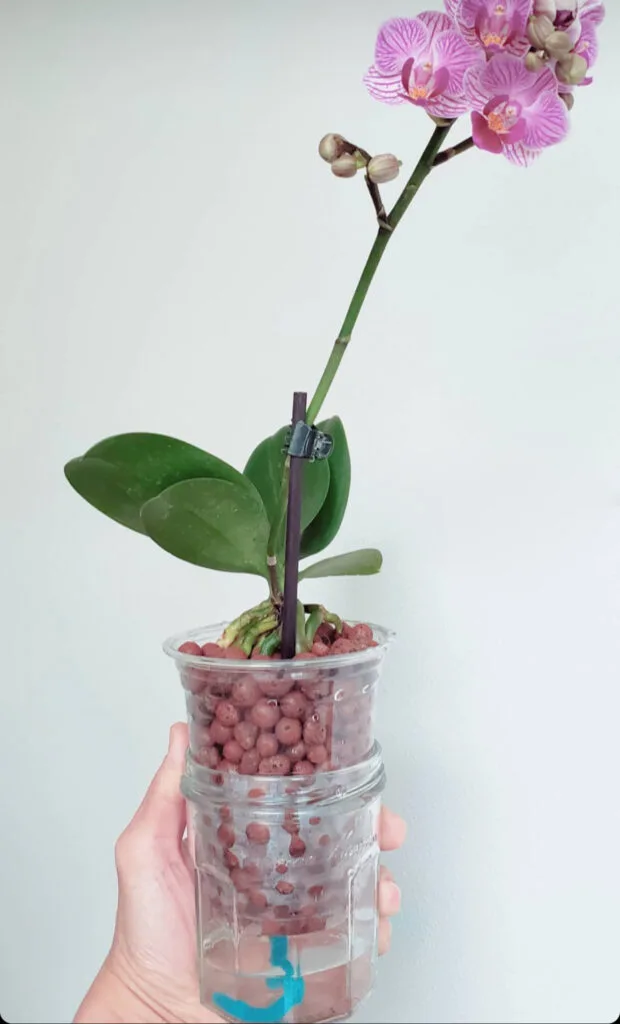
This is a set-up made my melelina_cattleya on Instagram. She has been successfully growing a variety of plants in LECA.
Here, a simple glass container and clear plastic drink container was used. For more details on this type of DIY set-up, check out my blog post Growing Houseplants in LECA.
I hope you’ve enjoyed this post on how to set up a semi-hydroponic system for your orchids. I will update this post as my plant makes progress (hopefully with new roots and a flower spike) and will add any insights that I develop along the way.


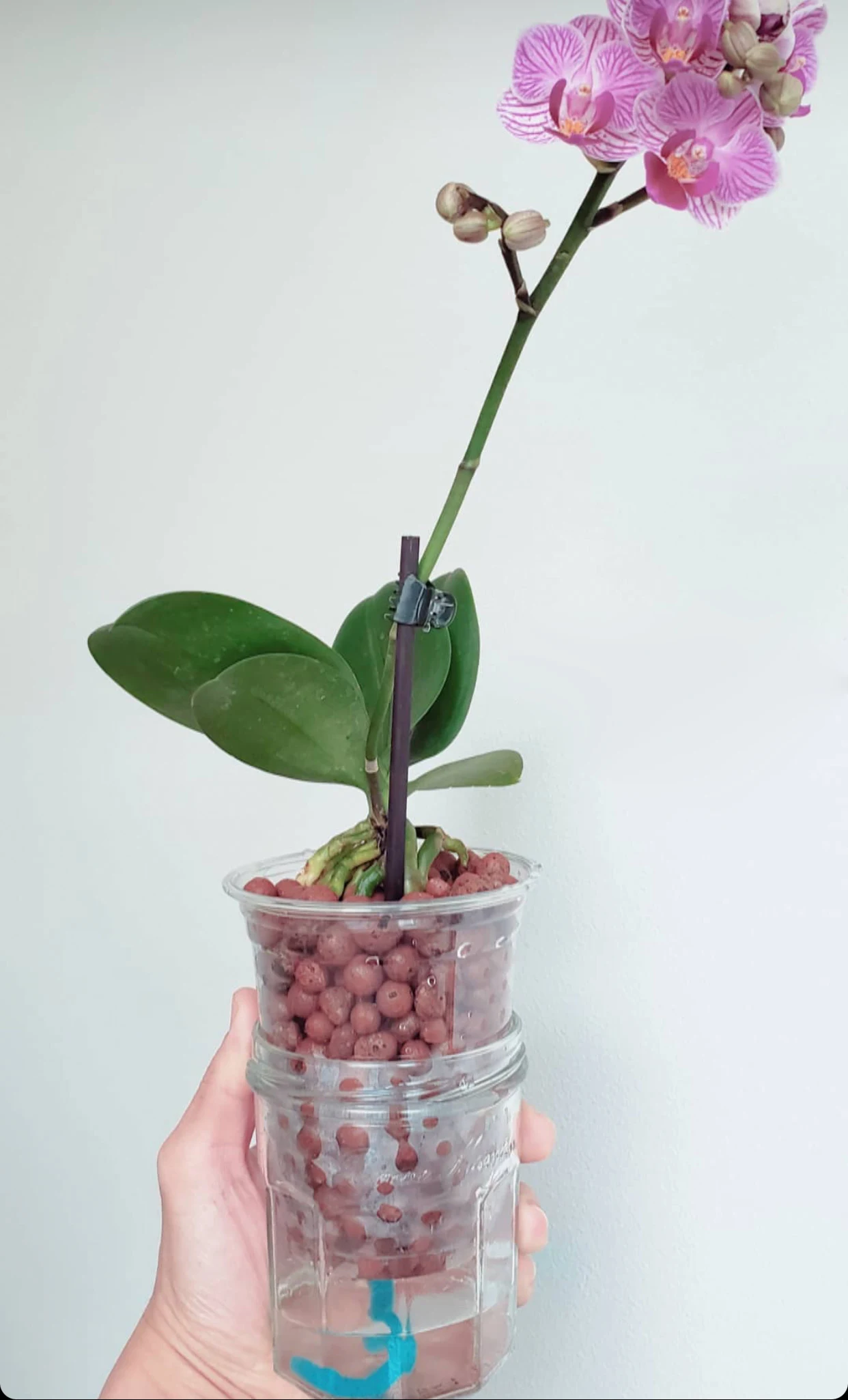
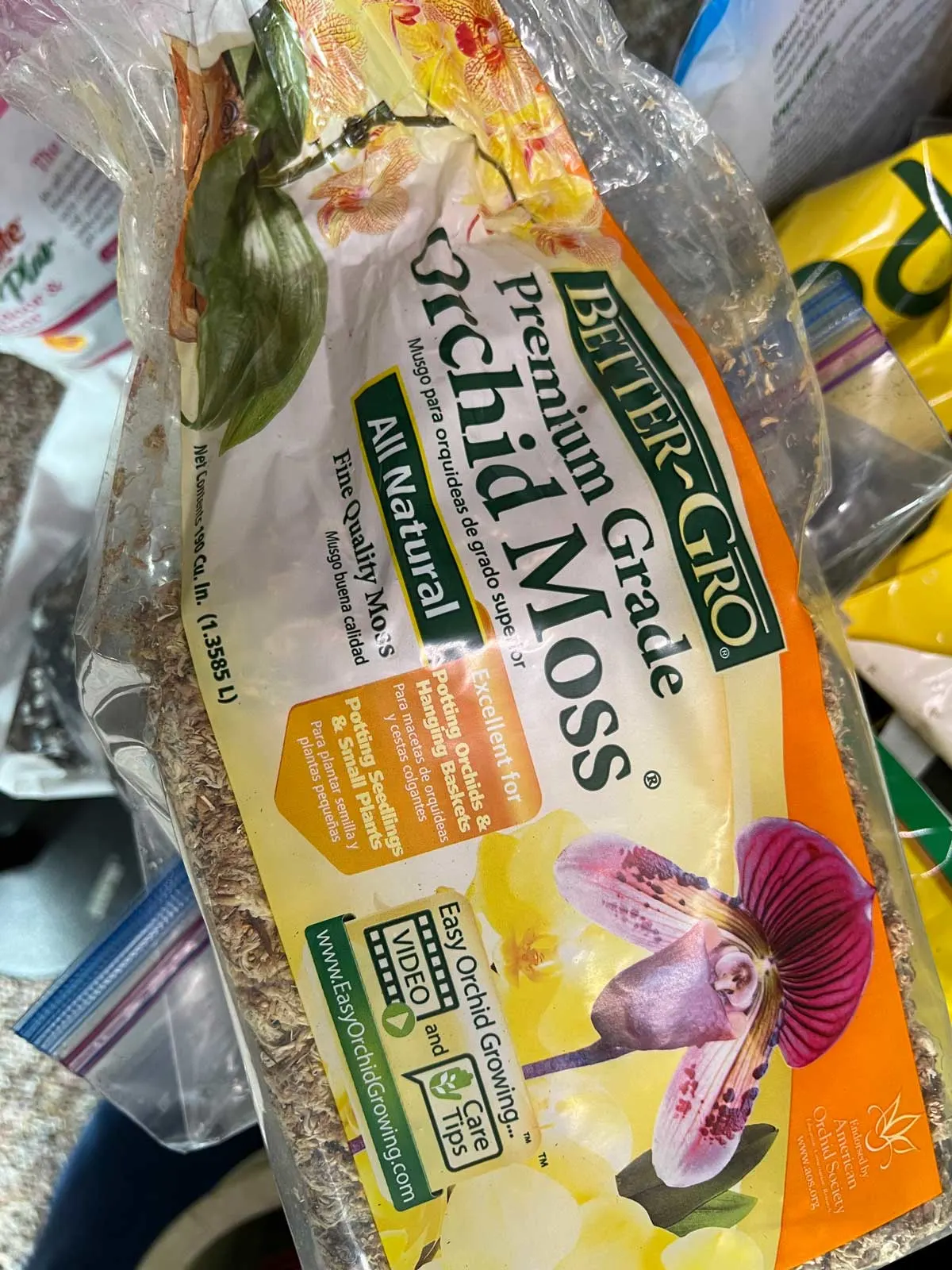
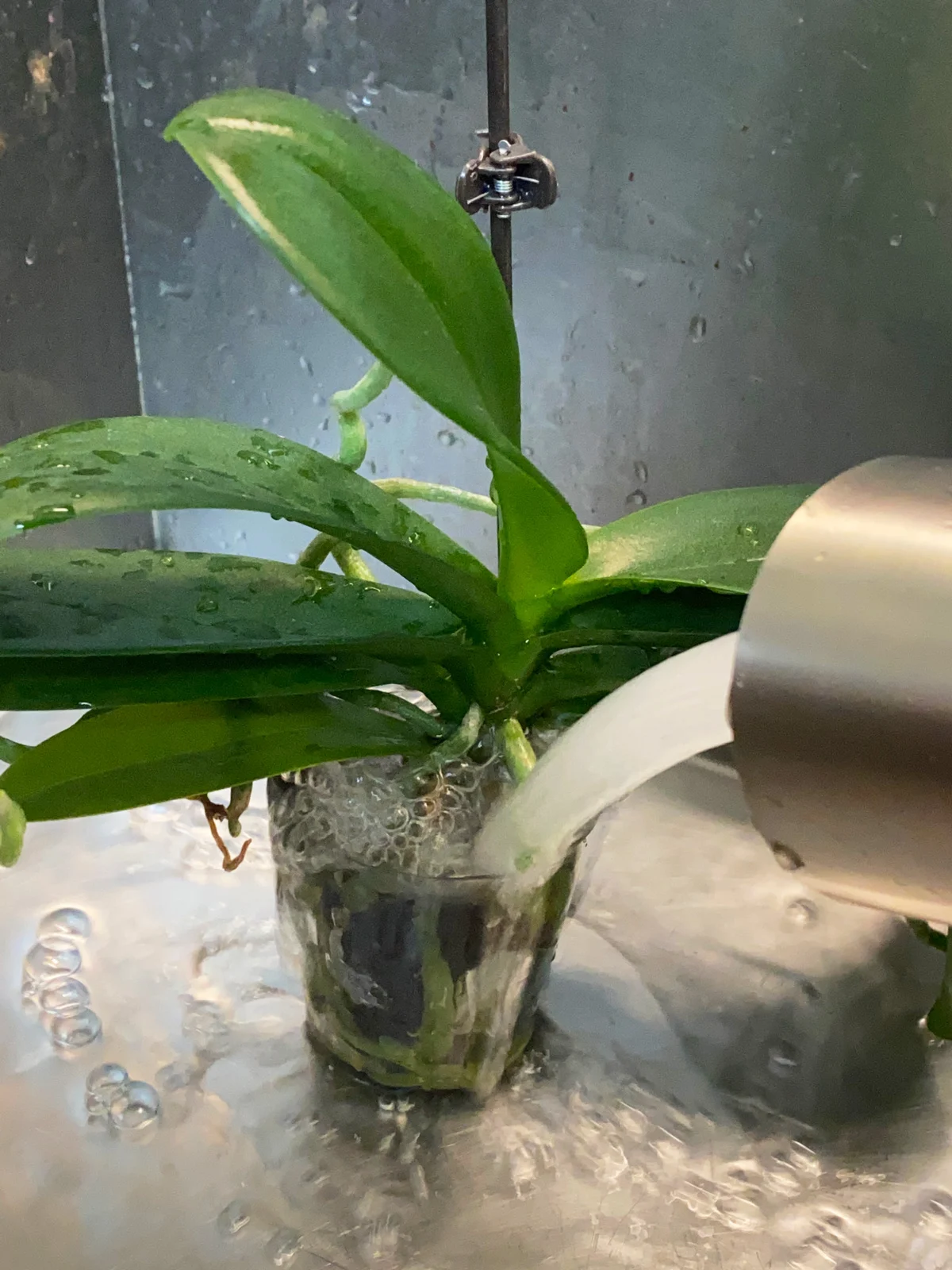
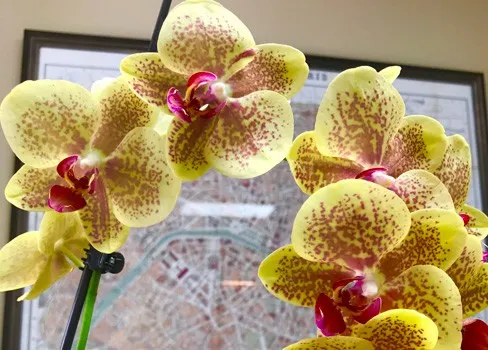
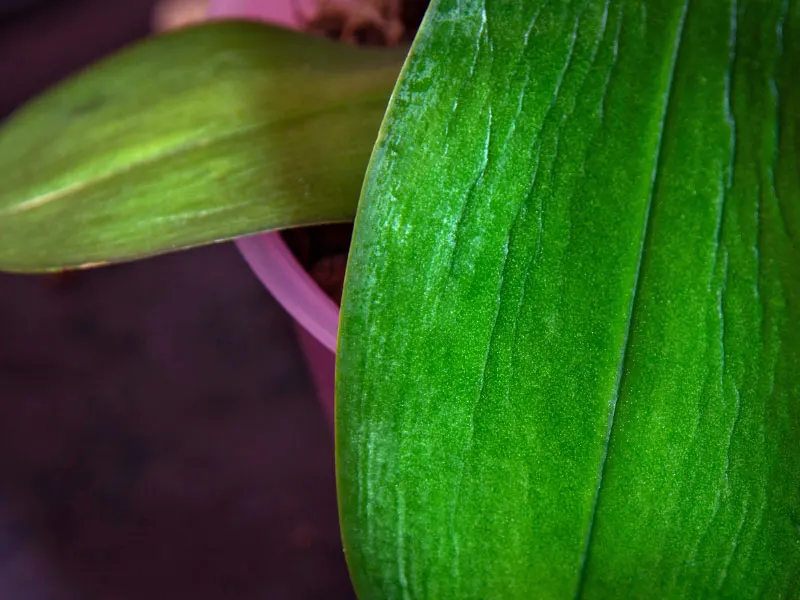
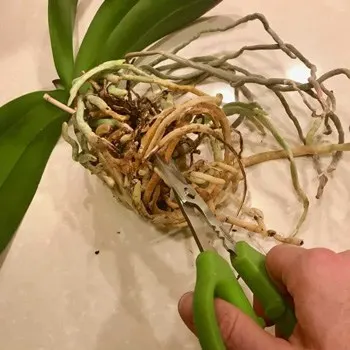
Maria Villanueva
Thursday 1st of February 2024
Hi! Can you switch the medium to LECA even when the orchid is still flowering?
Maria Villanueva
Monday 5th of February 2024
@Raffaele Di Lallo, thank you for your prompt response.
Raffaele Di Lallo
Friday 2nd of February 2024
Hi Maria! It's probably best to wait until flower is over before transitioning.
Sam
Monday 28th of August 2023
You pretty strongly caution readers not to use cotton for the wick in their LECA pots... then the Amazon page your reccomended wick link goes to features a wick made of... cotton. :-(
I think Amazon may have changed that link on you.
Raffaele
Tuesday 29th of August 2023
Hi Sam! Thanks for pointing that out. The product in the link does have a polyester exterior even though the base is cotton. I will tweak the wording to be a little clearer! I meant to say to avoid 100% cotton. Will edit now! Thanks again.
J.Arian
Thursday 2nd of March 2023
Orchids grow just fine in water. Not many realize this, but they actually do better in water. You do not submerse the entire root system but istead only add about 20-30% water to whatever container the orchid will be in. Orchids also grow amazingly in LECA with water at the bottom. No need for the self wicking either.
Lori
Tuesday 14th of March 2023
@J.Arian, I have several in water like you mentioned and they are very happy. Im interested in trying LECA too, how would you set up the pot to use LECA with water at the bottom without a wick?
Raffaele
Thursday 2nd of March 2023
Glad you've had success with that! I only have one in LECA with the wicking system and it's doing great.
Steph
Sunday 19th of June 2022
Do you have to fo the self watering wicking method, or can you just water the leca as needed?
Raffaele
Monday 20th of June 2022
If you want a self-watering pot, then yes, you need to use the wick. Otherwise there is no point to use the self-watering pot. You can just use LECA as the medium in a normal pot that is not self-watering though.
Jacque
Wednesday 2nd of March 2022
What happens if the roots grow out the bottom of the pot into the water? And how do you know when it's time to repot?
Raffaele
Sunday 6th of March 2022
They can stay quite a while in the same pot, especially in LECA. If the roots are in water too long, they will probably rot. Is your plant growing in a clear plastic pot? It will be easier to see if you have a pot full of roots if you grow them in clear plastic pots. If not, as long your plant is growing well, I wouldn't be too concerned. LECA won't break down, so you can keep them much longer than orchids growing in bark or sphagnum moss.